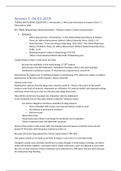Session 1: 04-02-2019
THEMES AND GUIDING QUESTIONS 1. Introduction 2. Why study the history of modern China? 3.
China before 1840
KEY TERMS Qing dynasty; Qianlong Emperor; Tributary system; Canton/cohong system
READINGS
o Jeffrey Wasserstrom, “Introduction,” in The Oxford Illustrated History of Modern
China, ed. Jeffrey Wasserstrom (Oxford: Oxford University Press, 2018), 1-10.
o Anne Gerritsen, “From Late Ming to High Qing, 1550-1860,” The Oxford Illustrated
History of Modern China, ed. Jeffrey Wasserstrom (Oxford: Oxford University Press,
2018), 11-36.
o Qianlong emperor’s letter to King George III (1793)
<https://sourcebooks.fordham.edu/mod/1793qianlong.asp>
Couple things to keep in mind about the Qing
- Became the wealthiest in the world during 17/18 th century
- Only because they did Sinification, maintained mantsjoe culture and used strategies
mentioned in prehistory classes retained way of governance, way of life
China before the Opium war Qianlong emperor scroll drawing 1751 where the welfare is evident,
depicted one of the tours of the emperor. Shows urban life.
Chinese world view
Painting that captures how the Qing rulers view the world ‘’China is the centre of the world’’,
involves some kind of hierarchy, dependant on civilisation Confucian beliefs and classical learning,
and those whom rise up in class are the ones that adopt these texts.
How did this world view translate into interaction with its neighbours?
It was translated into an interstate relation called the Tributary system
- You declare allegiance and show civilisation to Qing emperor
o Show civilisation with classics and classical Chinese scripts in court
o No embassy or permanent residence
o Perform rituals
- Hierarchical order
- Vassal states paid tribute in exchange for protection and recognition
- Tribute combined trade and diplomatic purposes
Only for these states in the picture (PP), but changed when European merchants came into the
picture the Dutch and Portuguese wanted to trade e.d.
Because of this the Qing opened the Canton Trade System 1700-1842
This system entails is not trade as we think of today, it was more of a controlled trade
Foreigners would come and they would have to trade through an intermediary Cohongs, not direct
trade with Chinese suppliers, merchants had to reside at the ports, were not allowed to even enter
the city, nor learn Chinese. These restrictions were imposed for a 100 years. The port grew because
the westerners kept flocking.
,Question about the Qianlong letter
- It reveals a couple of points
o It reinforces the point that China sees itself as the centre of the world, his blatant
rejection of the proposal where King George wants ambassadors in both courts is in
Qing perspective preposterous.
o This notion of ambassadorship is completely alien for him. It’s impossible to change
the way of communication between states the Qing has been done for ages.
o Britain needs China, not the other way around so Qing sees themselves as better,
since the Hongs wants are being met Chinese are doing the British a favour,
Session 2: 11-02-2019
THEMES AND GUIDING QUESTIONS
1. First Opium War
a. What were the causes of the First Opium War?
b. What were its consequences for Qing China?
2. Peasant Rebellions
a. What caused the waves of peasant rebellions in Qing China?
b. How do we understand domestic unrest in the context of growing foreign intrusion?
KEY TERMS First Opium War (1839-1842); Treaty of Nanjing (1842); Imperialism; Treaty ports;
Extraterritorial rights; Unequal treaties; Taiping Rebellion (1850-1864)
READINGS
Stephen R. Platt, “New Domestic and Global Challenges, 1792-1860,” in The Oxford
Illustrated History of Modern China, ed. Jeffrey Wasserstrom (Oxford: Oxford University
Press, 2018), 37-62.
Lin Zexu’s Letter to Queen Victoria (1839)
https://sourcebooks.fordham.edu/mod/1839lin2.asp>
Treaty of Nanjing (1842) < http://china.usc.edu/treaty-nanjing-nanking-1842>
Global Challenges
Last time: Qianlong letter where he explicitly rejected a British embassy and loosing restrictions on
trade in Canton shows attitude on trade and their worldview
First Opium War 1839 -1843
Opium was at the heart of conflict British got them Qings addicted to make trade balance even
Within 3 decades by 1840s 1 million heavy users. Flow silver reversed and moved out from China
to London.
Debates about legalisation or banning. Ended up banning it
Letter to Queen Victoria from Lin Zexu moral plea to stop trading opium in China
, Lin then confiscated a lot of
drugs and it angered the Brits
so they declared war.
Treaty of Nanjing
1842
This treaty led to another war
Second opium war
1856-1860
- Also known as the Arrow war or the Anglo-French War
- Qing Chinese conflicts with British and later French escalated into military confrontation in
Nov 1856
- Treaty of Tianjin in 1858, but fighting resumed ended when Beijing got sacked in oct 1860
by the British.
- Qing forced to ratify Treaty of Tianjin and conceded Kowloon to British.
The ‘’New treaty System’’
Inaugurated era of unequal treaties or gunboat diplomacy
- Treaty of Bogue 1843 or supplementary treaty of 1843
o most-favoured nation clause ‘’special member card’’
- Treaty of Wanghia extraterritorial rights
o Subjects residing in Qing were subject to British jurisdiction and not Qing jurisdiction
- Treaty of Whampoa extended rights to Christianity
- Treaty of Tianjin more treaty ports, freedom of movement in hinterland
Domestic Challenges
Domestic revolts and internal threats: rebellions in the Qing Empire, 1850-1870s
Social tensions in min-19th century
- Population growth and no increase of arable land
- Migration to ethnic minorities area, especially SW and SE China Land conflicts
- Unemployed and underemployed literati
- Corruption and rising taxation burden
- Neglect of public utilities and infrastructure
- Foreign ideas; Christianity
Taiping rebellion 1850-1864
- Lasted 14 years
- Leader: Hong Xiuquan
o Failed 3x exam
o Had delusions of being Tianzi and brother of Jesus






